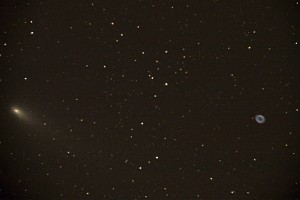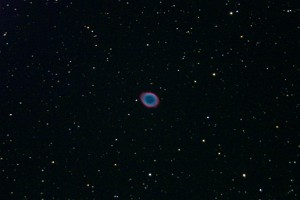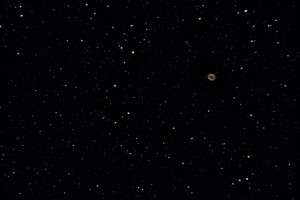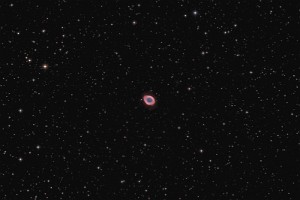
M57 and Comet Schwassmann-Wachmann 3

M57
Object: M57 Date: June 20, 2007 Location: "My-Spot" Observatory, West Bloomfield, Michigan (4.2 ZLM) Exposure(s): 34 x 5 Min @ ISO 200 (170 Minutes) Camera: Unmodified Konica Minolta Maxxum 7D Equipement: 10"-f/10 Meade OTA w/GEG and focal reducer at f/7.5 on Losmandy G-11 Guide Scope: ETX90 OTA and SBIG ST-4 Software & Processing: RAW image files were dark frame subtracted and converted to Tif files using my RawHide RAW file converter. The Tifs were then aligned and stacked using Registar 1.0.7 and then processed and cropped using Picture Window Pro.

M57
Object: M57 - The Ring Nebula Date: August 4, 2001 Exposure(s): 18 Min, 18 Min Film: Kodak LE400 Equipement: 10" f/10 Meade OTA w/GEG @ f/6.3 on Losmandy G-11 Guiding: SBIG ST-4 Hardware & Software: HP S20xi film scanner, Hamrick Software's VueScan, The raw image scans were processed, cropped, and then digitally stacked using Picture Window. Image Info: My image of M57 really suprised me do to the fact that I took it under my light polluted skies and during a full moon! This image was one of the first times I really saw a grain reduction in an image by stacking. The stars do not show any tracking problems, further confirming that I have made useful improvements to my G-11. The 14.7 mag central star in very clear. This is a BIG improvement over my first M57 image. Object Info: M57, the Ring Nebula. The distance to M57 is not really well known but most estimates are in the 2000 to 3000 ly range with a few beening farther out then that.

M57_HaRGB_800
Object: M57 Location: My-Spot Observatory Date(s): May 14, 19, 23, 24, 28, 30, & 31, 2010 (7 Nights) Scope: Vixen VC200L w/Focal Reducer Mount: Losmandy G-11 Guiding: ST80 OTA with QHY5 Camera: QHY8Pro Exposure: 52 x 300 Secs (RGB), 372 x 120 Secs (RGB), 98 x 600 Secs (Ha) (Total 33 Hours, 4 Mins) 254 x 120 Sec (8Hrs 28Mins) Lights (128 Flats, 128 Bias) Processing: Nebulosity and fitswork4, Stacked in DSS and final processing with PWP The Story: O.K. So I went a little nutts with this one. My goal was to reveal M57's the faint outer halo. After more then 33 Hours of exposure time I could declare success! Much of the imaging time was spent during the time of the full moon so even with the narrowband (12nm) Ha filter, there wasn't as much depth as I had hoped for. One strange issue was that the central star has all but disappeared in all of the processing.